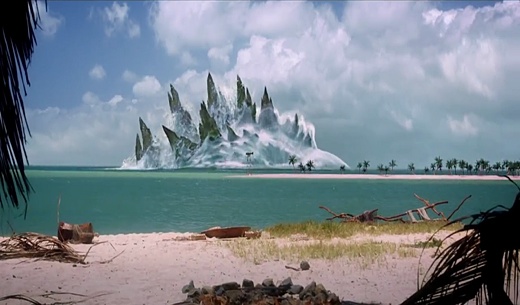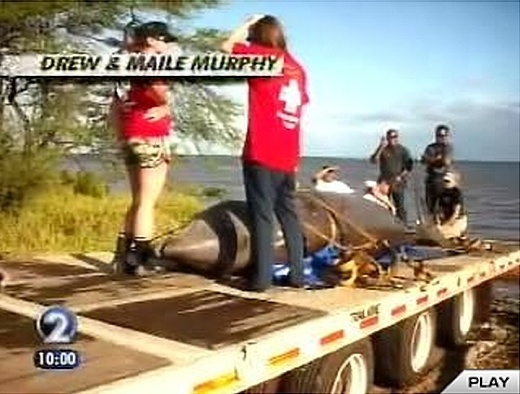SUBHEAD: Eastward ho! A look 500 years into the likely future climate of North America.
By John Michael Greer on 30 July 2014 for the Archdruid Report -
(http://thearchdruidreport.blogspot.com/2014/07/dark-age-america-climate.html)

Image above: Warming climate may spread drying to a third of Earth, says study. From (http://phys.org/news/2014-03-climate-earth.html).
[IB Publisher's note: It is relevant that micro-climate can be affected by small groups of people. So start planting a low-maintenance, fast growing start to a food forest wherever you are now. Keep at it and add longer maturing and delicate plants as soil, moisture, shade and other conditions warrant. There is no excuse not to make where you are the greenest oasis possible.]
Over the next year or so, as I’ve mentioned in recent posts, I plan on tracing out as much as possible of what can be known or reasonably guessed about the next five hundred years or so of North American history—the period of the decline and fall of the civilization that now occupies that continent, the dark age in which that familiar trajectory ends, and the first stirrings of the successor societies that will rise out of its ruins.
That’s a challenging project, arguably more so than anything else I’ve attempted here, and it also involves some presuppositions that may be unfamiliar even to my regular readers.
To begin with, I’m approaching history—the history of the past as well as of the future—from a strictly ecological standpoint.
I’d like to propose, in fact, that history might best be understood as the ecology of human communities, traced along the dimension of time.
Like every other ecological process, in other words, it’s shaped partly by the pressures of the senvironment and partly by the way its own subsystems interact with one another, and with the subsystems of the other ecologies around it.
That’s not a common view; most historical writing these days puts human beings at the center of the picture, with the natural world as a supposedly static background, while a minority view goes to the other extreme and fixates on natural catastrophes as the sole cause of this or that major historical change.
Neither of these approaches seem particularly useful to me.
As our civilization has been trying its level best not to learn for the last couple of centuries, and thus will be learning the hard way in the years immediately ahead, the natural world is not a static background. It’s an active and constantly changing presence that responds in complex ways to human actions.
Human societies, in turn, are equally active and equally changeable, and respond in complex ways to nature’s actions.
The strange loops generated by a dance of action and interaction along these lines are difficult to track by the usual tools of linear thinking, but they’re the bread and butter of systems theory, and also of all those branches of ecology that treat the ecosystem rather than the individual organism as the basic unit.
The easiest way to show how this perspective works is to watch it in action, and it so happens that one of the most important factors that will shape the history of North America over the next five centuries is particularly amenable to a systems analysis.
The factor I have in mind is climate.
Now of course that’s also a political hot potato just at the moment, due to the unwillingness of a great many people across the industrial world to deal with the hard fact that they can’t continue to enjoy their current lifestyles if they want a climatically and ecologically stable planet to live on.
It doesn’t matter how often the planet sets new heat records, nor that the fabled Northwest Passage around the top end of Canada—which has been choked with ice since the beginning of recorded history—is open water every summer nowadays, and an increasingly important route for commercial shipping from Europe to the eastern shores of Asia.
Every time the planet’s increasingly chaotic weather spits out unseasonably cold days in a few places, you can count on hearing well-paid flacks and passionate amateurs alike insisting at the top of their lungs that this proves that anthropogenic climate change is nonsense.
To the extent that this reaction isn’t just propaganda, it shows a blindness to systems phenomena I’ve discussed here before: a learned inability to recognize that change in complex systems does not follow the sort of nice straight lines our current habits of thought prefer.
A simple experiment can help show how complex systems respond in the real world, and in the process make it easier to make sense of the sort of climate phenomena we can count on seeing in the decades ahead.
The next time you fill a bathtub, once you’ve turned off the tap, wait until the water is still. Slip your hand into the water, slowly and gently, so that you make as little disturbance in the water as possible.
Then move your hand through the water about as fast as a snail moves, and watch and feel how the water adapts to the movement, flowing gently around your hand. .
Once you’ve gotten a clear sense of that, gradually increase the speed with which your hand is moving.
After you pass a certain threshold of speed, the movements of the water will take the form of visible waves—a bow wave in front of your hand, a wake behind it in which water rises and falls rhythmically, and wave patterns extending out to the edges of the tub.
The faster you move your hand, the larger the waves become, and the more visible the interference patterns as they collide with one another.
Keep on increasing the speed of your hand. You’ll pass a second threshold, and the rhythm of the waves will disintegrate into turbulence: the water will churn, splash, and spray around your hand, and chaotic surges of water will lurch up and down the sides of the tub.
If you keep it up, you can get a fair fraction of the bathwater on your bathroom floor, but this isn’t required for the experiment!
Once you’ve got a good sense of the difference between the turbulence above the second threshold and the oscillations below it, take your hand out of the water, and watch what happens: the turbulence subsides into wave patterns, the waves shrink, and finally—after some minutes—you have still water again.
This same sequence of responses can be traced in every complex system, governing its response to every kind of disturbance in its surroundings.
So long as the change stays below a certain threshold of intensity and rapidity—a threshold that differs for every system and every kind of change—the system will respond smoothly, with the least adjustment that will maintain its own internal balance.
Once that threshold is surpassed, oscillations of various kinds spread through the system, growing steadily more extreme as the disturbance becomes stronger, until it passes the second threshold and the system’s oscillations collapse into turbulence and chaos.
When chaotic behavior begins to emerge in an oscillating system, in other words, that’s a sign that real trouble may be sitting on the doorstep.
If global temperature were increasing in a nice even line, in other words, we wouldn’t have as much to worry about, because it would be clear from that fact that the resilience of the planet’s climate system was well able to handle the changes that were in process.
Once things begin to oscillate, veering outside usual conditions in both directions, that’s a sign that the limits to resilience are coming into sight, with the possibility of chaotic variability in the planetary climate as a whole waiting not far beyond that.
We can fine-tune the warning signals a good deal by remembering that every system is made up of subsystems, and those of sub-subsystems, and as a general rule of thumb, the smaller the system, the more readily it moves from local adjustment to oscillation to turbulence in response to rising levels of disturbance.
Local climate is sensitive enough, in fact, that ordinary seasonal changes can yield minor turbulence, which is why the weather is so hard to predict; regional climates are more stable, and normally cycle through an assortment of wavelike oscillations; the cycle of the seasons is one, but there are also multiyear and multidecade cycles of climate that can be tracked on a regional basis.
It’s when those regional patterns start showing chaotic behavior—when, let’s say, the usually sizzling Texas summer is suddenly broken by a record cold snap in the middle of July, in a summer that’s shaping up globally to be among the hottest ever measured—that you know the whole system is coming under strain.

Image above: Ahem. Channel 7 KLTV StormTracker - "Longview, Texas - 71º Coolest High Temperature EVER in the month of July since 1902". From (http://www.kltv.com/story/26058367/48-hours-for-the-weather-record-books-in-east-texas).
I’m not generally a fan of Thomas Friedman, but he scored a direct hit when he warned that what we have to worry about from anthropogenic climate change is not global warming but "global weirding:" in the terms I’ve used in this post, the emergence of chaotic shifts out of a global climate that’s been hit with too much disturbance too fast.
A linear change in global temperatures would be harsh, but it would be possible to some extent to shift crop belts smoothly north in the northern hemisphere and south in the southern.
If the crop belts disintegrate—if you don’t know whether the next season is going to be warm or cold, wet or dry, short or long—famines become hard to avoid, and cascading impacts on an already strained global economy add to the fun and games.
At this point, for the reasons just shown, that’s the most likely shape of the century or two ahead of us.
In theory, some of that could be avoided if the world’s nations were to stop treating the skies as an aerial sewer in which to dump greenhouse gases.
In practice—well, I’ve met far too many climate change activists who still insist that they have to have SUVs to take their kids to soccer practice, and I recall the embarrassed silence that spread a while back when an important British climate scientist pointed out that maybe jetting all over the place to climate conferences was communicating the wrong message at a time when climate scientists and everyone else needed to decrease their carbon footprint.
Until the people who claim to be concerned about climate change start showing a willingness to burn much less carbon, it’s unlikely that anyone else will do so, and so I think it’s a pretty safe bet that fossil fuels will continue to be extracted and burnt as long as geological and economic realities permit.
The one bleak consolation here is that those realities are a good deal less flexible than worst-case scenarios generally assume.
There are two factors in particular to track here, and both unfold from net energy—the difference between the energy content of fossil fuels as they reach the end consumer and the energy input needed to get them all the way there.
The first factor is simply that if a deposit of fossil carbon takes more energy to extract, process, and transport to the end user than the end user can get by burning it, the fossil carbon will stay in the ground.
The poster child here is kerogen shale, which has been the bane of four decades of enthusiastic energy projects in the American West and elsewhere.
There’s an immense amount of energy locked up in the Green River shale and its equivalents, but every attempt to break into that cookie jar has come to grief on the hard fact that, all things considered, it takes more energy to extract kerogen from shale than you get from burning the kerogen.
The second factor is subtler and considerably more damaging. A
s fossil fuel deposits with abundant net energy are exhausted, and have to be replaced by deposits with lower net energy, a larger and larger fraction of the total energy supply available to an industrial society has to be diverted from all other economic uses to the process of keeping the energy flowing.
Thus it’s not enough to point to high total energy production and insist that all’s well; the logic of net energy has to be applied here as well, and the total energy input to energy production, processing, and distribution subtracted from total energy production, to get a realistic sense of how much energy is available to power the rest of the economy—and the rest of the economy, remember, is what produces the wealth that makes it possible for individuals, communities, and nations to afford fossil fuels in the first place.
Long before the last physically extractable deposit of fossil fuel is exhausted, in other words, fossil fuel extraction will have to stop because it’s become an energy sink rather than an energy source.
Well before that point is reached, furthermore, the ability of global and national economies to meet the energy costs of fossil fuel extraction will slam face first into hard limits.
Demand destruction, which is what economists call the process by which people who can’t afford to buy a product stop using it, is as important here as raw physical depletion; as economies reel under the twin burdens of depleting reserves and rising energy costs for energy production, carbon footprints will shrink willy-nilly as rapid downward mobility becomes the order of the day for most people.
Combine these factors with the economic impacts of "global weirding" itself and you’ve got a good first approximation of the forces that are already massing to terminate the fossil fuel economy with extreme prejudice in the decades ahead.
How those are likely to play out the future we’re facing will be discussed at length in several future posts.
For the time being, I’ll just note that I expect global fossil fuel consumption and CO2 emissions to peak within a decade or so to either side of 2030, and then tip over into a ragged and accelerating decline, punctuated by economic and natural disasters, that will reach the zero point of the scale well before 2100.
What that means for the future climate of North America is difficult to predict in detail but not so hard to trace in outline.
From now until the end of the 21st century, perhaps longer, we can expect climate chaos, accelerating in its geographical spread and collective impact until a couple of decades after CO2 emissions peak, due to the lag time between when greenhouse gases hit the atmosphere and when their effects finally peak.
As the rate of emissions slows thereafter, the turbulence will gradually abate, and some time after that—exactly when is anybody’s guess, but 2300 or so is as good a guess as any—the global climate will have settled down into a "new normal" that won’t be normal by our standards at all.
Barring further curveballs from humanity or nature, that "new normal" will remain until enough excess CO2 has been absorbed by natural cycles to matter—a process that will take several millennia at least, and therefore falls outside the range of the five centuries or so I want to consider here.
An educated guess at the shape of the "new normal" is possible, because for the last few million years or so, the paleoclimatology of North America has shown a fairly reliable pattern.
The colder North America has been, by and large, the heavier the rainfall in the western half of the continent.
During the last Ice Age, for example, rainfall in what’s now the desert Southwest was so heavy that it produced a chain of huge pluvial (that is, rain-fed) lakes and supported relatively abundant grassland and forest ecosystems across much of what’s now sagebrush and cactus country.
Some measure of the difference can be caught from the fact that 18,000 years ago, when the last Ice Age was at its height, Death Valley was a sparkling lake surrounded by pine forests.
By contrast, the warmer North America becomes, the dryer the western half of the continent gets, and the drying effect spreads east a very long ways.
After the end of the last Ice Age, for example, the world entered what nowadays gets called the Holocene Climatic Optimum; that term’s a misnomer, at least for this continent, because conditions over a good bit of North America then were optimum only for sand fleas and Gila monsters.
There’s been a running debate for several decades about whether the Hypsithermal, to use the so-called Optimum’s other name, was warmer than today all over the planet or just in some regions.
Current opinion tends to favor the latter, but the difference doesn’t actually have that much impact on the issue we’re considering: the evidence from a broad range of sources shows that North America was significantly warmer in the Hypsithermal than it is today, and so that period makes a fairly good first approximation of the conditions this continent is likely to face in a warmer world.
To make sense of the long-term change to North American climates, it’s important to remember that rainfall is far more important than temperature as a determining factor for local ecosystems.
If a given region gets more than about 40 inches of rain a year, no matter what the temperature, it’ll normally support some kind of forest; if it gets between 40 and 10 inches a year, you’ve got grassland or, in polar regions, mosses and lichens; if you get less than 10 inches a year, you’ve got desert, whether it’s as hot as the Sahara or as bitterly cold as the Takla Makan.
In the Hypsithermal, as the west dried out, tallgrass prairie extended straight across the Midwest to western Pennsylvania, and much of the Great Plains were desert, complete with sand dunes.
In a world with ample fossil fuel supplies, it’s been possible to ignore such concerns, to the extent of pumping billions of gallons of water a year from aquifers or distant catchment basins to grow crops in deserts and the driest of grasslands, but as fossil fuel supplies sunset out, the shape of human settlement will once again be a function of annual rainfall, as it was everywhere on the planet before 1900 or so.
If the Hypsithermal’s a valid model, as seems most likely, most of North America from the Sierra Nevada and Cascade ranges east across the Great Basin and Rocky Mountains to the Great Plains will be desert, as inhospitable as any on Earth, and human settlement will be accordingly sparse: scattered towns in those few places where geology allows a permanent water supply, separated by vast desolate regions inhabited by few hardy nomads or by no one at all.
East of the Great Desert, grassland will extend for a thousand miles or more, east to the Allegheny foothills, north to a thinner and dryer boreal forest belt shifted several hundred miles closer to the Arctic Ocean, and south to the tropical jungles of the Gulf coast.
Further south, in what’s now Mexico, the tropical rain belt will move northwards with shifts in the global atmospheric circulation, and the Gulf coast east of the Sierra Madre Oriental will shift to tropical ecosystems all the way north to, and beyond, the current international border.
Between the greatly expanded tropical zone in the south and east and the hyperarid deserts of the north, Mexico will be a land of sharp ecological contrasts
Factor in sea level rise, on the one hand, and the long-term impacts of soil depletion and of toxic and radioactive wastes on the other—issues complicated enough in their causes, trajectory, and results that they’re going to require separate posts—and you’ve got a fairly limited set of regions in which agriculture will be possible in a post-fossil fuel environment: basically, the eastern seaboard from the new coast west to the Alleghenies and the Great Lakes, and river valleys in the eastern half of the Mississippi basin.
The midwestern grasslands will support pastoral grazing, and the jungle belts around the new Gulf coast and across southern Mexico will be suitable for tropical crops once the soil has a chance to recover, but the overall human carrying capacity of the continent will be significantly smaller than it was before the industrial age began.
Climate isn’t the only force pushing in that direction, either. We’ll get to the others in the weeks ahead as we continue exploring the deindustrial landscapes of dark age America.
.
By John Michael Greer on 30 July 2014 for the Archdruid Report -
(http://thearchdruidreport.blogspot.com/2014/07/dark-age-america-climate.html)

Image above: Warming climate may spread drying to a third of Earth, says study. From (http://phys.org/news/2014-03-climate-earth.html).
[IB Publisher's note: It is relevant that micro-climate can be affected by small groups of people. So start planting a low-maintenance, fast growing start to a food forest wherever you are now. Keep at it and add longer maturing and delicate plants as soil, moisture, shade and other conditions warrant. There is no excuse not to make where you are the greenest oasis possible.]
Over the next year or so, as I’ve mentioned in recent posts, I plan on tracing out as much as possible of what can be known or reasonably guessed about the next five hundred years or so of North American history—the period of the decline and fall of the civilization that now occupies that continent, the dark age in which that familiar trajectory ends, and the first stirrings of the successor societies that will rise out of its ruins.
That’s a challenging project, arguably more so than anything else I’ve attempted here, and it also involves some presuppositions that may be unfamiliar even to my regular readers.
To begin with, I’m approaching history—the history of the past as well as of the future—from a strictly ecological standpoint.
I’d like to propose, in fact, that history might best be understood as the ecology of human communities, traced along the dimension of time.
Like every other ecological process, in other words, it’s shaped partly by the pressures of the senvironment and partly by the way its own subsystems interact with one another, and with the subsystems of the other ecologies around it.
That’s not a common view; most historical writing these days puts human beings at the center of the picture, with the natural world as a supposedly static background, while a minority view goes to the other extreme and fixates on natural catastrophes as the sole cause of this or that major historical change.
Neither of these approaches seem particularly useful to me.
As our civilization has been trying its level best not to learn for the last couple of centuries, and thus will be learning the hard way in the years immediately ahead, the natural world is not a static background. It’s an active and constantly changing presence that responds in complex ways to human actions.
Human societies, in turn, are equally active and equally changeable, and respond in complex ways to nature’s actions.
The strange loops generated by a dance of action and interaction along these lines are difficult to track by the usual tools of linear thinking, but they’re the bread and butter of systems theory, and also of all those branches of ecology that treat the ecosystem rather than the individual organism as the basic unit.
The easiest way to show how this perspective works is to watch it in action, and it so happens that one of the most important factors that will shape the history of North America over the next five centuries is particularly amenable to a systems analysis.
The factor I have in mind is climate.
Now of course that’s also a political hot potato just at the moment, due to the unwillingness of a great many people across the industrial world to deal with the hard fact that they can’t continue to enjoy their current lifestyles if they want a climatically and ecologically stable planet to live on.
It doesn’t matter how often the planet sets new heat records, nor that the fabled Northwest Passage around the top end of Canada—which has been choked with ice since the beginning of recorded history—is open water every summer nowadays, and an increasingly important route for commercial shipping from Europe to the eastern shores of Asia.
Every time the planet’s increasingly chaotic weather spits out unseasonably cold days in a few places, you can count on hearing well-paid flacks and passionate amateurs alike insisting at the top of their lungs that this proves that anthropogenic climate change is nonsense.
To the extent that this reaction isn’t just propaganda, it shows a blindness to systems phenomena I’ve discussed here before: a learned inability to recognize that change in complex systems does not follow the sort of nice straight lines our current habits of thought prefer.
A simple experiment can help show how complex systems respond in the real world, and in the process make it easier to make sense of the sort of climate phenomena we can count on seeing in the decades ahead.
The next time you fill a bathtub, once you’ve turned off the tap, wait until the water is still. Slip your hand into the water, slowly and gently, so that you make as little disturbance in the water as possible.
Then move your hand through the water about as fast as a snail moves, and watch and feel how the water adapts to the movement, flowing gently around your hand. .
Once you’ve gotten a clear sense of that, gradually increase the speed with which your hand is moving.
After you pass a certain threshold of speed, the movements of the water will take the form of visible waves—a bow wave in front of your hand, a wake behind it in which water rises and falls rhythmically, and wave patterns extending out to the edges of the tub.
The faster you move your hand, the larger the waves become, and the more visible the interference patterns as they collide with one another.
Keep on increasing the speed of your hand. You’ll pass a second threshold, and the rhythm of the waves will disintegrate into turbulence: the water will churn, splash, and spray around your hand, and chaotic surges of water will lurch up and down the sides of the tub.
If you keep it up, you can get a fair fraction of the bathwater on your bathroom floor, but this isn’t required for the experiment!
Once you’ve got a good sense of the difference between the turbulence above the second threshold and the oscillations below it, take your hand out of the water, and watch what happens: the turbulence subsides into wave patterns, the waves shrink, and finally—after some minutes—you have still water again.
This same sequence of responses can be traced in every complex system, governing its response to every kind of disturbance in its surroundings.
So long as the change stays below a certain threshold of intensity and rapidity—a threshold that differs for every system and every kind of change—the system will respond smoothly, with the least adjustment that will maintain its own internal balance.
Once that threshold is surpassed, oscillations of various kinds spread through the system, growing steadily more extreme as the disturbance becomes stronger, until it passes the second threshold and the system’s oscillations collapse into turbulence and chaos.
When chaotic behavior begins to emerge in an oscillating system, in other words, that’s a sign that real trouble may be sitting on the doorstep.
If global temperature were increasing in a nice even line, in other words, we wouldn’t have as much to worry about, because it would be clear from that fact that the resilience of the planet’s climate system was well able to handle the changes that were in process.
Once things begin to oscillate, veering outside usual conditions in both directions, that’s a sign that the limits to resilience are coming into sight, with the possibility of chaotic variability in the planetary climate as a whole waiting not far beyond that.
We can fine-tune the warning signals a good deal by remembering that every system is made up of subsystems, and those of sub-subsystems, and as a general rule of thumb, the smaller the system, the more readily it moves from local adjustment to oscillation to turbulence in response to rising levels of disturbance.
Local climate is sensitive enough, in fact, that ordinary seasonal changes can yield minor turbulence, which is why the weather is so hard to predict; regional climates are more stable, and normally cycle through an assortment of wavelike oscillations; the cycle of the seasons is one, but there are also multiyear and multidecade cycles of climate that can be tracked on a regional basis.
It’s when those regional patterns start showing chaotic behavior—when, let’s say, the usually sizzling Texas summer is suddenly broken by a record cold snap in the middle of July, in a summer that’s shaping up globally to be among the hottest ever measured—that you know the whole system is coming under strain.

Image above: Ahem. Channel 7 KLTV StormTracker - "Longview, Texas - 71º Coolest High Temperature EVER in the month of July since 1902". From (http://www.kltv.com/story/26058367/48-hours-for-the-weather-record-books-in-east-texas).
I’m not generally a fan of Thomas Friedman, but he scored a direct hit when he warned that what we have to worry about from anthropogenic climate change is not global warming but "global weirding:" in the terms I’ve used in this post, the emergence of chaotic shifts out of a global climate that’s been hit with too much disturbance too fast.
A linear change in global temperatures would be harsh, but it would be possible to some extent to shift crop belts smoothly north in the northern hemisphere and south in the southern.
If the crop belts disintegrate—if you don’t know whether the next season is going to be warm or cold, wet or dry, short or long—famines become hard to avoid, and cascading impacts on an already strained global economy add to the fun and games.
At this point, for the reasons just shown, that’s the most likely shape of the century or two ahead of us.
In theory, some of that could be avoided if the world’s nations were to stop treating the skies as an aerial sewer in which to dump greenhouse gases.
In practice—well, I’ve met far too many climate change activists who still insist that they have to have SUVs to take their kids to soccer practice, and I recall the embarrassed silence that spread a while back when an important British climate scientist pointed out that maybe jetting all over the place to climate conferences was communicating the wrong message at a time when climate scientists and everyone else needed to decrease their carbon footprint.
Until the people who claim to be concerned about climate change start showing a willingness to burn much less carbon, it’s unlikely that anyone else will do so, and so I think it’s a pretty safe bet that fossil fuels will continue to be extracted and burnt as long as geological and economic realities permit.
The one bleak consolation here is that those realities are a good deal less flexible than worst-case scenarios generally assume.
There are two factors in particular to track here, and both unfold from net energy—the difference between the energy content of fossil fuels as they reach the end consumer and the energy input needed to get them all the way there.
The first factor is simply that if a deposit of fossil carbon takes more energy to extract, process, and transport to the end user than the end user can get by burning it, the fossil carbon will stay in the ground.
The poster child here is kerogen shale, which has been the bane of four decades of enthusiastic energy projects in the American West and elsewhere.
There’s an immense amount of energy locked up in the Green River shale and its equivalents, but every attempt to break into that cookie jar has come to grief on the hard fact that, all things considered, it takes more energy to extract kerogen from shale than you get from burning the kerogen.
The second factor is subtler and considerably more damaging. A
s fossil fuel deposits with abundant net energy are exhausted, and have to be replaced by deposits with lower net energy, a larger and larger fraction of the total energy supply available to an industrial society has to be diverted from all other economic uses to the process of keeping the energy flowing.
Thus it’s not enough to point to high total energy production and insist that all’s well; the logic of net energy has to be applied here as well, and the total energy input to energy production, processing, and distribution subtracted from total energy production, to get a realistic sense of how much energy is available to power the rest of the economy—and the rest of the economy, remember, is what produces the wealth that makes it possible for individuals, communities, and nations to afford fossil fuels in the first place.
Long before the last physically extractable deposit of fossil fuel is exhausted, in other words, fossil fuel extraction will have to stop because it’s become an energy sink rather than an energy source.
Well before that point is reached, furthermore, the ability of global and national economies to meet the energy costs of fossil fuel extraction will slam face first into hard limits.
Demand destruction, which is what economists call the process by which people who can’t afford to buy a product stop using it, is as important here as raw physical depletion; as economies reel under the twin burdens of depleting reserves and rising energy costs for energy production, carbon footprints will shrink willy-nilly as rapid downward mobility becomes the order of the day for most people.
Combine these factors with the economic impacts of "global weirding" itself and you’ve got a good first approximation of the forces that are already massing to terminate the fossil fuel economy with extreme prejudice in the decades ahead.
How those are likely to play out the future we’re facing will be discussed at length in several future posts.
For the time being, I’ll just note that I expect global fossil fuel consumption and CO2 emissions to peak within a decade or so to either side of 2030, and then tip over into a ragged and accelerating decline, punctuated by economic and natural disasters, that will reach the zero point of the scale well before 2100.
What that means for the future climate of North America is difficult to predict in detail but not so hard to trace in outline.
From now until the end of the 21st century, perhaps longer, we can expect climate chaos, accelerating in its geographical spread and collective impact until a couple of decades after CO2 emissions peak, due to the lag time between when greenhouse gases hit the atmosphere and when their effects finally peak.
As the rate of emissions slows thereafter, the turbulence will gradually abate, and some time after that—exactly when is anybody’s guess, but 2300 or so is as good a guess as any—the global climate will have settled down into a "new normal" that won’t be normal by our standards at all.
Barring further curveballs from humanity or nature, that "new normal" will remain until enough excess CO2 has been absorbed by natural cycles to matter—a process that will take several millennia at least, and therefore falls outside the range of the five centuries or so I want to consider here.
An educated guess at the shape of the "new normal" is possible, because for the last few million years or so, the paleoclimatology of North America has shown a fairly reliable pattern.
The colder North America has been, by and large, the heavier the rainfall in the western half of the continent.
During the last Ice Age, for example, rainfall in what’s now the desert Southwest was so heavy that it produced a chain of huge pluvial (that is, rain-fed) lakes and supported relatively abundant grassland and forest ecosystems across much of what’s now sagebrush and cactus country.
Some measure of the difference can be caught from the fact that 18,000 years ago, when the last Ice Age was at its height, Death Valley was a sparkling lake surrounded by pine forests.
By contrast, the warmer North America becomes, the dryer the western half of the continent gets, and the drying effect spreads east a very long ways.
After the end of the last Ice Age, for example, the world entered what nowadays gets called the Holocene Climatic Optimum; that term’s a misnomer, at least for this continent, because conditions over a good bit of North America then were optimum only for sand fleas and Gila monsters.
There’s been a running debate for several decades about whether the Hypsithermal, to use the so-called Optimum’s other name, was warmer than today all over the planet or just in some regions.
Current opinion tends to favor the latter, but the difference doesn’t actually have that much impact on the issue we’re considering: the evidence from a broad range of sources shows that North America was significantly warmer in the Hypsithermal than it is today, and so that period makes a fairly good first approximation of the conditions this continent is likely to face in a warmer world.
To make sense of the long-term change to North American climates, it’s important to remember that rainfall is far more important than temperature as a determining factor for local ecosystems.
If a given region gets more than about 40 inches of rain a year, no matter what the temperature, it’ll normally support some kind of forest; if it gets between 40 and 10 inches a year, you’ve got grassland or, in polar regions, mosses and lichens; if you get less than 10 inches a year, you’ve got desert, whether it’s as hot as the Sahara or as bitterly cold as the Takla Makan.
In the Hypsithermal, as the west dried out, tallgrass prairie extended straight across the Midwest to western Pennsylvania, and much of the Great Plains were desert, complete with sand dunes.
In a world with ample fossil fuel supplies, it’s been possible to ignore such concerns, to the extent of pumping billions of gallons of water a year from aquifers or distant catchment basins to grow crops in deserts and the driest of grasslands, but as fossil fuel supplies sunset out, the shape of human settlement will once again be a function of annual rainfall, as it was everywhere on the planet before 1900 or so.
If the Hypsithermal’s a valid model, as seems most likely, most of North America from the Sierra Nevada and Cascade ranges east across the Great Basin and Rocky Mountains to the Great Plains will be desert, as inhospitable as any on Earth, and human settlement will be accordingly sparse: scattered towns in those few places where geology allows a permanent water supply, separated by vast desolate regions inhabited by few hardy nomads or by no one at all.
East of the Great Desert, grassland will extend for a thousand miles or more, east to the Allegheny foothills, north to a thinner and dryer boreal forest belt shifted several hundred miles closer to the Arctic Ocean, and south to the tropical jungles of the Gulf coast.
Further south, in what’s now Mexico, the tropical rain belt will move northwards with shifts in the global atmospheric circulation, and the Gulf coast east of the Sierra Madre Oriental will shift to tropical ecosystems all the way north to, and beyond, the current international border.
Between the greatly expanded tropical zone in the south and east and the hyperarid deserts of the north, Mexico will be a land of sharp ecological contrasts
Factor in sea level rise, on the one hand, and the long-term impacts of soil depletion and of toxic and radioactive wastes on the other—issues complicated enough in their causes, trajectory, and results that they’re going to require separate posts—and you’ve got a fairly limited set of regions in which agriculture will be possible in a post-fossil fuel environment: basically, the eastern seaboard from the new coast west to the Alleghenies and the Great Lakes, and river valleys in the eastern half of the Mississippi basin.
The midwestern grasslands will support pastoral grazing, and the jungle belts around the new Gulf coast and across southern Mexico will be suitable for tropical crops once the soil has a chance to recover, but the overall human carrying capacity of the continent will be significantly smaller than it was before the industrial age began.
Climate isn’t the only force pushing in that direction, either. We’ll get to the others in the weeks ahead as we continue exploring the deindustrial landscapes of dark age America.
.











